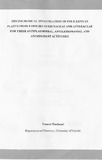| dc.description.abstract | In an effort made to address the problem of malaria and its associated complications, four Kenyan plants used to treat malaria were investigated for compounds with antiplasmodial and anti-oxidant activities. The plants are Clerodendrum eriophyllum (Verbenaceae), Sphaeranthus bullatus (Asteraceae), Microglossa pyrifolia (Asteraceae) and Vernonia galamensis (Asteraceae). A total of forty-two compounds were isolated from the plants, two being new, namely 12-hydroxy-8,12-abietadiene-3,1l,14-trione (220) from Clerodendrum eriophyllum and 8-acetoxyisochiliolide lactone (248) from Microglossa pyrifolia.
The antifungal, antibacterial and antileishmanial activity of compounds were also investigated. Separation of compounds was carried out using chromatographic methods and their identification done by spectroscopic methods. The in vitro anti-plasmodial tests were done by a colorimetric assay that determined the parasitic lactate dehydrogenase (PLDH) activity in 96-well microplate. Antioxidants were analysed by UV -VIS spectrometry method employing the stable radical compound DPPH. From the roots of Clerodendrum eriophyllum, fifteen compounds were isolated, being twelve abietane diterpenoids, two triterpenoids and a long chain ester of tyro sol.
The abietane diterpenoids had anti-plasmodial activities, these are taxodione (222), 6- hydroxysalvinolone (226) and 6,16-dihydroxysalvinolone (227), with IC50 of 1.2 ug/ml, 1.8 ug/ml and 3 ug/ml respectively against chloroquine sensitive D6 strain, 1.2 ug/ml, 2.5 ug/ml and 4.8 ug/ml respectively against chloroquine sensitive W2 strains of P. falciparum. Anti-oxidant activities were observed on four abietane diterpenoids, taxodione (222), 6-hydroxysalvinolone (226), 6,16-dihydroxysalvinolone (227) and Nellionol (228) with IC50 of 31.S±0.8, 17.7±O.4, 20.5±0.5 and 10.2±0.S respectively. Antifungal activitivies were observed on taxodione (222), 6-hydroxysalvinolone (226) and 6,16-dihydroxysalvinolone (227), the best activity observed with taxodione (222) on Cryptococcus neoformans (lCso 0.58 ug/ml).
The aerial parts of Sphaeranthus bullatus gave seventeen compounds being five carvotacetone monoterpene derivatives, three p-isopropyltoluene derivatives, five flavonoids, two phenyl propanoids and two triterpenes. Four carvotacetone derivatives had anti-plasmodial activities. These were 3,S,7-trihydroxycarvotacetone (85), 3-acetoxy- 5,7 dihydroxycarvotacetone (106), 3,7-dihydroxy-S-tigloyloxycarvotacetone (88) and 3- acetoxy-7-hydroxy-S-tigloyloxycarvotacetone (99), with ICso of 3.4 ug/ml, 0.6 ug/ml, 0.8 flg/ml and 1.4 ug/ml respectively against chloroquine sensitive D6 strain as well as 2.8 ug/ml, O. 7 ug/ml, 0.9 ug/ml and 2.0 ug/ml respectively against chloroquine sensitive W2 strains of P. falciparum. This is a first encounter of antiplasmodial activity on carvotacetone derivatives. The two phenyl propanoids, caffeic acid (240) and coniferaldehyde (241) showed anti-oxidant activities, with Ie' of 2.6±0.3 and 14.1 ±O.6 ! respectively. The aerial parts of Microglossa pyrifolia afforded six compounds. These were two rearranged clerodane diterpenoids, two steroids, one triterpenoid and one eudesman sesquiterpene. The compounds from this plant showed no activities.
The aerial parts of Vernonia galamensis gave seven compounds; five flavanols, one lignan and one benzenoid. The compounds showed no anti-plasmodial activitiy, but showed anti-oxidant activities, with ICso of 6.0±0.2 for quercetin (235), 6.6±0.3 for quercetin 3-methylether (244), 10.4±0.5 for crysoplenol D (238), 9.3±0.4 for quercetin 3- O-p-galactopyranoside (212), 12.9 ± 0.4 for quercetin 3-0-p-rhamnopyranoside (245), 8.3 ± 0.4 for Syringic acid (247) and 21.0 ± 0.5 ug/ml for syringaresinol (246). Anti-microbial activities were observed with the abietane diterpenoids taxodione (222), ferruginol (224), 6-hydroxysalvinolone (226) and 6,16-dihydroxysalvinolone (227). Best antifungal activity was shown by taxodione (222) and 6-hydroxysalvinolone (226) (ICso 0.58 and 0.96 ug/ml respectively against C. neoformans) where as best antibacterial activity was shown by ferruginol (224) on methicillin-resistant Staphylococcus aureus (MRS) (ICso 0.96 ug/ml). The best antileishmanial activity was shown by taxodione (222) (lCso 0.08 ug/ml against L. donovani). | en_US |

